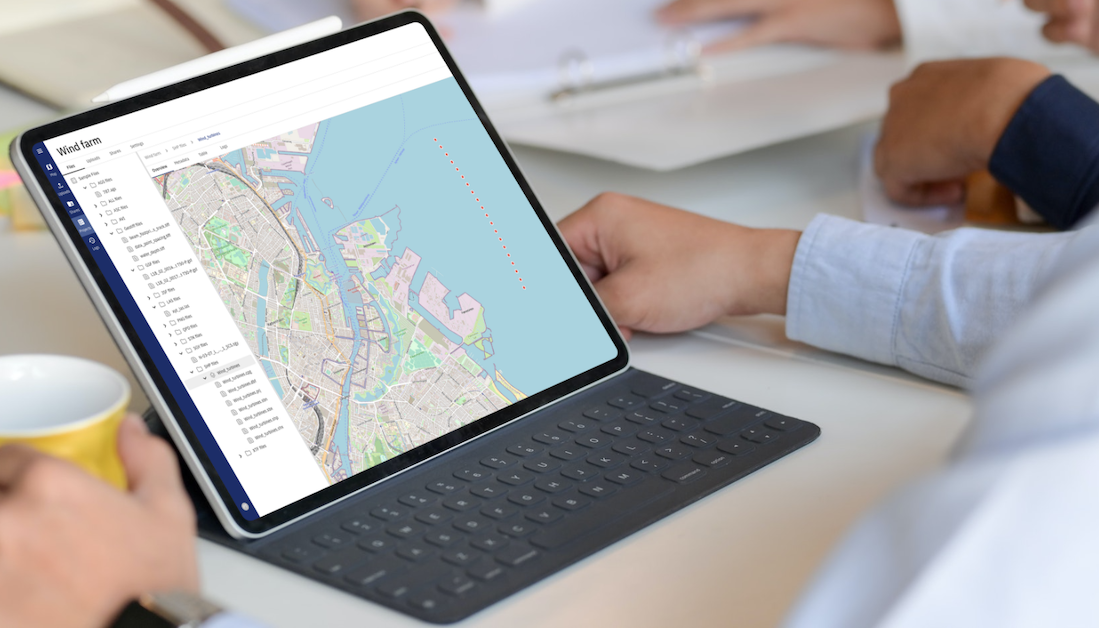The rapid growth of offshore wind farms has led to an increased demand for accurate and reliable data and data management. The marine data could be split into two categories: (1) sensor data acquired during different survey work and (2) non-sensor data like documentation, planning/design, and assessments. The sensor data provide information about e.g., water depths, currents, wave heights, and seabed conditions and are stored in various file formats as they are remotely sensed or directly measured and sampled. Combining these various file formats into comprehensive and realistic data products (e.g., maps) of the marine environment is crucial for planning, constructing, and operating wind farms efficiently. In this article, we will delve into the significance of data file formats, explore marine surveys, examine several types of marine sensors, discuss underwater sensor data and non-sensor data file formats.
Marine Data Platform trueocean.io
The Importance of Marine Data in Offshore Wind Farm
Operations
Offshore wind farms require extensive marine data to ensure their successful planning, construction, and operation. Accordingly, sensor data are acquired through surveys and aim to deliver a comprehensive picture of the marine environment. Accurate and up-to-
date data are vital for making informed decisions, mitigating risks, and optimizing wind farm performance.
Marine Surveys: Unveiling the Underwater World
Marine surveys are conducted to measure and image the ocean environment. They involve the use of specialized vessels, instruments, and techniques. They acquire information such as bathymetry, seabed composition, chemical and physical water properties, and biological parameters. This information built the foundation to comprehensively assess the feasibility and suitability of a specific location for offshore wind energy projects.
Types of Marine Sensors
Marine surveys rely on specialized equipment and techniques to collect essential data. Common marine sensors used in these surveys include echosounders, side scan sonars, sub-bottom profilers, towed streamers, magnetometers, and underwater sampling tools. Each sensor serves a specific purpose, such as bathymetric mapping, seafloor imaging, identifying geological layers, detecting magnetic anomalies, and studying marine life and environmental conditions. These sensors play a crucial role in gathering accurate information for various offshore activities, including wind farm planning, environmental assessments, and resource exploration. The diverse set of tools and the challenging survey environment result in a broad variety of processing workflows and file formats.
Sensor Data File Formats
Various file formats are used to store and share data obtained from underwater sensors during marine surveys. Multibeam echosounders provide data of the seafloor depth (bathymetry) and the seabed texture (backscatter). Multibeam data are stored and shared in a variety of different formats depending on their processing level (e.g., raw data, processed data, data product). The most commonly used formats comprise ALL, KMALL, S7K, GSF, XTF, XYZ, LAS, LAZ, and GeoTiff. For side scan sonar data, the most commonly used file formats are XTF, JSF, SDF, and GeoTiff, which provide detailed seafloor texture information. Subbottom profiler data reveal geological layers and reflections in the subsurface and are typically stored and shared as SEG-Y and SEG-D files. Magnetometer data are typically stored in XYZ and CSV files, indicating magnetic anomalies on and below the seabed. For underwater sampling data, file formats may vary depending on the type of data collected, including XLSX, CSV, PDF, DOCX, or specialized geological software formats for biological, chemical, and geological samples. Using cameras to create images (JPEG, PNG, TIFF) and videos (MP4, MOV, AVI) allows stakeholders,
engineers, and planners to effectively visualize the proposed wind farm, communicate ideas, and document findings throughout the planning process.
Each format has its advantages and disadvantages regarding data storage, interoperability, and analysis capabilities. For example, ASCII formats (e.g., XYZ, CSV) are commonly readable by almost every software, but typically result in large files making them inefficient for storage and sharing. In contrast, binary formats are optimized for efficient storing, fast input/output speed, and sharing large data volumes. However, the variety of different binary file formats makes the processing and analysis more complex. Unifying different sensor data formats into a common file format is a challenging task as information needs to be merged accurately. Therefore, unification and standardization processes are typically avoided in the current workflows, despite the immense potential of a common, unified file formats for improved data management (Wehner et al., 2022 – https://doi.org/10.58440/ihr-28-a10).
Non-Sensor Data File Formats
To construct and maintain an offshore wind farm, data regarding project documentation, engineering designs, and environmental impact assessments etc. must be properly managed. These non-sensor related data are typically stored and shared in PDF, DOCX, XLSX, and CAD files. Efficient handling of these formats ensures proper document management throughout the wind farm. They play a crucial role in facilitating collaboration, decision-making, and public engagement in offshore wind farm projects.
Unifying Data File Formats: Enhancing Offshore Wind Farm
Planning and Performance
The rapid growth of offshore wind farms has sparked an increased demand for accurate and reliable data. Informed data handling and unifying the heterogenous data file formats are vital for efficiently planning, constructing, and operating wind farms. Geophysical and geotechnical surveys, along with marine sensors, provide critical information about the marine environment, aiding in-site assessments and risk mitigation. A unification of the different data file formats obtained from these surveys will enable a faster informed decision-making process and an optimized wind farm performance.
A unified data format leads to faster turnaround times and efficient workflows, and hence reduces costs. Efficient data management and file sharing moves more and more from individual desktop computers and local file servers towards web-based cloud services. Therefore, data formats optimized for this infrastructure become more and more important. An example for such a unified, cloud-optimized data file format is the Apache Parquet format (https://parquet.apache.org/)., which is open-source, cloud-native, highly compressible, and interoperable with most programming languages (Wehner et. Al., 2022



























